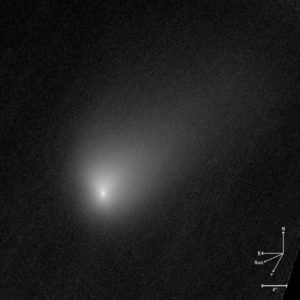2I / Borisov
| 2I / Borisov [i] | |
|---|---|

|
|
| 2I / Borisov on October 12, 2019, captured with the Wide Field Camera 3 of the Hubble Space Telescope | |
| Properties of the orbit ( animation ) | |
| Orbit type | hyperbolic |
| Numerical eccentricity | 3.4 |
| Perihelion | 2.0 AU |
| Inclination of the orbit plane | 44 ° |
| Perihelion | December 8, 2019 |
| Physical properties of the core | |
| Medium diameter | <1 km |
| history | |
| Explorer | L51 (Gennady Borisov) |
| Date of discovery | August 30, 2019 |
| Older name | C / 2019 Q4 (Borisov), gb00234 |
| Source: Unless otherwise stated, the data comes from JPL Small-Body Database Browser . Please also note the note on comet articles . | |

2I / Borisov also 2019 Q4 C / (Borisov) called , is a comet on a hyperbolic path through the solar system . The numerical eccentricity of its orbit is about 3.4. It is an interstellar object that is only deflected by the gravitation of the sun and then leaves the solar system again.
discovery
The object was discovered on August 30, 2019 by the amateur astronomer Gennady Vladimirovich Borisov (Borisov) in the Crimea with the help of a self-made 65 cm telescope. The Minor Planet Center (MPC) at the Harvard-Smithsonian Center for Astrophysics determined a comet orbit similar to Borisov and named it C / 2019 Q4 (Borisov) after the discoverer. After confirming its origin from interstellar space , the MPC gave it the new designation 2I / Borisov as the second interstellar object observed in the solar system after 1I / ʻOumuamua .
Comet orbit
On its orbit, the comet from the direction of the constellation Cassiopeia hit the ecliptic , which it crossed on October 26, 2019, at an angle of about 45 ° . It reached its closest point to the sun on December 8, 2019, passing the sun at twice the distance from the earth. It reached the closest approximation of 300 million kilometers to the earth at the end of 2019. It should be tracked until September 2020 .
Physical Properties
Since the comet was in the sky near the sun after its discovery, it could only be examined for about 1–2 hours per night. In September he had already formed a coma and his diameter was initially determined to be 2–16 kilometers. However, images from the Hubble telescope showed a significantly smaller size of less than a kilometer.
A spectrum in the visible range recorded on September 13, 2019 with the Gran Telescopio Canarias indicates a surface composition similar to that of typical comets from the Oort cloud . It differs clearly from the first interstellar object 1I / ʻOumuamua observed in the solar system .
At the beginning of March 2020, several outbursts of brightness were observed at the comet's core. At the end of March, it was discovered on images taken by the Hubble Space Telescope that 2I / Borisov had broken in two.
Web links
- Rendezvous with an interstellar intruder at Spektrum.de
Individual evidence
- ↑ Interstellar Comet 2I / Borisov Swings Past Sun. Retrieved December 16, 2019 .
- ↑ a b MPEC 2019-S72: 2I / Borisov = C / 2019 Q4 (Borisov). In: Minor Planet Center. September 24, 2019, accessed on September 24, 2019 .
- ^ Another Interstellar Visitor Is Headed Our Way. In: Sky & Telescope. September 11, 2019. Retrieved September 13, 2019 (American English).
- ↑ Jonathan O'Callaghan: A Second Interstellar Object Has Almost Certainly Been Found In Our Solar System. In: forbes.com. September 11, 2019, accessed September 12, 2019 .
- ↑ COMET C / 2019 Q4 (Borisov). September 11, 2019, accessed September 11, 2019 .
- ↑ Lars Fischer: Comet on a strange path: New interstellar visitor sighted? In: Spektrum.de. Spectrum of Science, September 11, 2019, accessed on September 11, 2019 .
- ↑ MPEC 2019-R106: COMET C / 2019 Q4 (Borisov). Retrieved March 3, 2020 .
- ↑ Interstellar Comet 2I / Borisov Swings Past Sun. Retrieved December 16, 2019 .
- ↑ The Gran Telescopio Canarias (GTC) obtains the visible spectrum of C / 2019 Q4 (Borisov), the first confirmed interstellar comet. In: Instituto de Astrofísica de Canarias . September 14, 2019, accessed on September 16, 2019 .
- ↑ Multiple Outbursts of Interstellar Comet 2I / Borisov. In: The Astronomerˋs Telegram. March 12, 2020, accessed April 5, 2020 .
- ↑ Interstellar Object 2I / Borisov Double. In: The Astronomerˋs Telegram. April 2, 2020, accessed April 5, 2020 .
- ↑ Interstellar Visitor is broken. In: Spektrum.de. April 3, 2020, accessed April 5, 2020 .